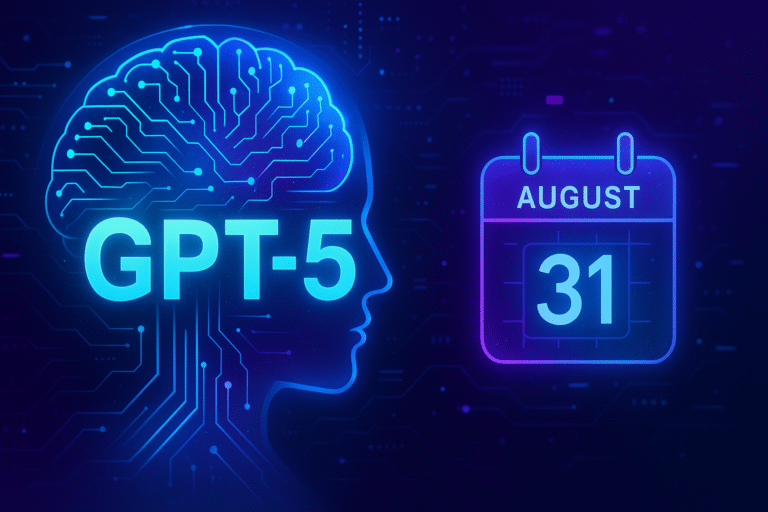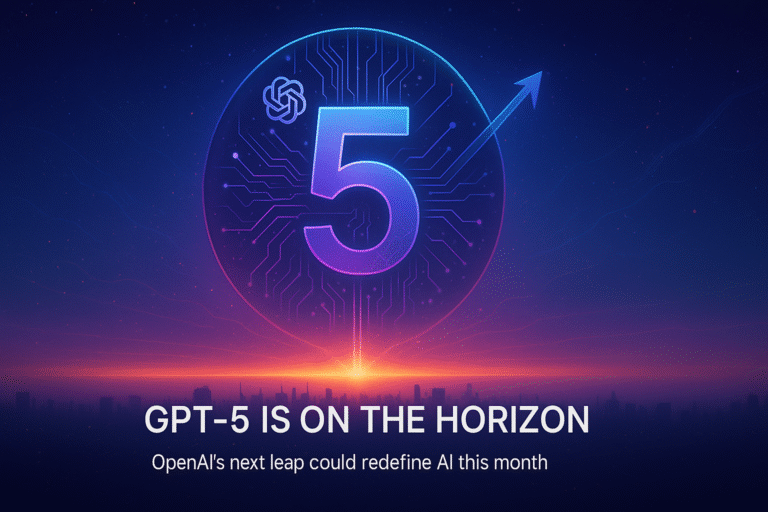
Imagine you’re at the edge of a cliff, peering into a foggy valley where the next big tech revolution is about to emerge. That’s the vibe surrounding OpenAI’s upcoming GPT-5 model right now. As whispers from industry insiders turn into full-blown reports, it seems the San Francisco-based AI powerhouse is gearing up to unleash its latest creation in early August 2025. This isn’t just another update; it’s poised to push the boundaries of what artificial intelligence can do, blending smarter reasoning with everyday usability. For tech newcomers, think of it as upgrading from a reliable old bicycle to a sleek electric scooter that anticipates your every turn. Seasoned pros? Get ready for a model that might finally bridge the gap between human-like intuition and machine efficiency.
Drawing from fresh scoops by tech journalists and analysts, GPT-5 isn’t arriving alone—it’s bringing mini and nano versions along for the ride, making advanced AI more accessible across devices and applications. But amid the excitement, there’s a dash of caution from OpenAI’s own CEO, Sam Altman, who likened the development to a “Manhattan Project” moment, admitting it sometimes keeps him up at night. Let’s unpack what’s brewing, why it matters, and how it could shake up everything from your daily chats to complex problem-solving.
The Road to GPT-5: From Hype to Reality
OpenAI has been on a tear since bursting onto the scene with ChatGPT back in late 2022, transforming how we interact with technology. Remember those early days when generating a simple poem felt magical? Fast-forward to today, and models like GPT-4o have already mastered voice conversations and image analysis. But GPT-5? Reports suggest it’s the culmination of years of iterative tweaks, powered by massive datasets and cutting-edge training techniques.
According to sources familiar with the company’s plans, the launch timeline has been accelerating. Just a few months ago, in June 2025, internal evaluations showed that no model was quite ready for the “GPT-5” badge. Yet, by late July, the pieces fell into place. This rapid pivot isn’t accidental—it’s driven by fierce competition from players like Google’s Gemini and Meta’s Llama series, not to mention xAI’s Grok models. OpenAI’s strategy? Ship faster, iterate publicly, and stay ahead in the AI arms race.
One quirky aside: Insiders hint that the rush might also stem from regulatory pressures. The European Union’s AI Act kicks in with stringent rules on transparency starting August 2, 2025. Launching just before could sidestep some bureaucratic hurdles, letting OpenAI focus on innovation rather than paperwork. It’s like sneaking in a midnight snack before the diet officially starts—smart, if a bit cheeky.
For those dipping their toes into AI waters, here’s a quick primer: GPT stands for Generative Pre-trained Transformer, a fancy way of saying it’s a system trained on vast swaths of internet text to predict and generate human-like responses. GPT-5 builds on this by incorporating “o-series” reasoning, a tech that allows the model to think step-by-step, much like how you’d puzzle through a crossword. No more superficial answers; expect deeper, more logical outputs.
What to Expect: Features That Could Blow Your Mind
Diving deeper, let’s explore the rumored specs that have tech circles buzzing. While OpenAI hasn’t dropped an official spec sheet—keeping us all on our toes like a suspenseful thriller—leaked details paint a vivid picture.
- Unified Reasoning Power: At the heart of GPT-5 is enhanced reasoning borrowed from the o3 model. This means the AI won’t just spit out facts; it’ll chain thoughts logically, handling multi-step problems with ease. Picture asking it to plan a vacation: It might not only suggest flights but also optimize for weather patterns, budget tweaks, and even cultural events, all while explaining its logic.
- Multimodal Magic: Gone are the days of text-only interactions. GPT-5 is expected to seamlessly blend text, images, voice, and video inputs. For creators, this could mean generating a storyboard from a voice description or editing photos based on verbal cues. It’s like giving your AI a pair of eyes and ears, turning it into a true digital companion.
- Longer Memory and Context: Early testers rave about expanded context windows—up to 20,000 tokens or more. In plain speak, that’s like the AI remembering an entire novel’s worth of conversation without losing the plot. For developers, this unlocks agent-style workflows: The model could explore code repositories, debug errors, and even execute browser tasks autonomously.
- Mini and Nano Variants: Not everyone needs the full beast. These scaled-down versions promise similar smarts in a lighter package, ideal for mobile apps or edge devices. Think of them as the espresso shots to GPT-5’s full latte—potent, portable, and perfect for on-the-go use.
- Tiered Access for All: Free users might get a taste via the mini models, while Plus and Pro subscribers unlock the full suite. There’s even talk of an open-source release akin to the old GPT-2, potentially dropping before month’s end. This could democratize AI, letting indie devs tinker without breaking the bank.
Expert insight for the pros: The architecture here is scalable, with execs whispering it could evolve all the way to “GPT-8” levels without a complete overhaul. That points to efficient training methods, possibly leveraging synthetic data to cut costs and environmental impact. But beware the hype—some analysts warn that while incremental gains are likely, quantum leaps in intelligence might still be a few iterations away.
To visualize the jump, consider this analogy: If GPT-3 was a clever student acing multiple-choice tests, GPT-4 added essay-writing skills. GPT-5? It’s aiming for PhD-level thesis defense, complete with original research and counterarguments.
The Buzz and the Backlash: Altman’s Fears and Industry Ripples
No tech story is complete without a bit of drama, and GPT-5 delivers. Sam Altman, OpenAI’s charismatic leader, didn’t mince words in recent interviews. “It feels very fast… I’m scared,” he said, comparing the project’s pace to historical tech breakthroughs that outran oversight. “What have we done?” indeed—echoing the sentiments of atomic pioneers.
This isn’t just CEO theater. As AI models grow more capable, concerns about misuse escalate. Could GPT-5 automate jobs en masse? Power deepfakes? Or worse, evade human control? Altman himself calls for stronger governance, noting there’s “no adults in the room” when it comes to global AI regulation. It’s a timely reminder that with great power comes great responsibility—or at least a lot of ethical debates.
On the flip side, the potential upsides are tantalizing. In software engineering, early tests show GPT-5 excelling at code generation, debugging, and even full app building. For hard sciences, it might accelerate drug discovery or climate modeling. Creative fields could see bursts of innovation, with AI co-authoring novels or composing music that rivals human artistry.
Key takeaways from the chatter:
- Performance Edge: Testers claim it outperforms rivals like Claude Sonnet 4 in head-to-heads, especially in engineering tasks.
- Hallucination Reduction: Fewer made-up facts, thanks to crisper instruction-following and emotional intelligence tweaks.
- Server Prep: Microsoft, OpenAI’s key partner, is already ramping up infrastructure, hinting at massive compute demands.
- Competition Heat: With Grok 4 fresh out and Gemini hitting 450 million users, GPT-5 needs to shine to maintain dominance.
For a broader view, check out this detailed breakdown on The Verge, where senior editor Tom Warren spills the beans on internal timelines.
Or dive into The Information’s deep dive on development hurdles for the full scoop.
Implications for Everyday Users and Businesses
So, what does this mean for you? If you’re a casual user firing up ChatGPT for homework help or recipe ideas, GPT-5 could make interactions feel eerily intuitive—like chatting with a know-it-all friend who never forgets details. Businesses, meanwhile, stand to gain big: Automated workflows could slash hours from data analysis, customer service, or content creation.
But let’s get practical. For small teams, the nano versions might integrate into tools like email clients or project managers, predicting needs before you ask. In education, it could personalize learning paths, adapting to a student’s pace and style. Healthcare pros might use it for preliminary diagnostics, cross-referencing symptoms with vast medical knowledge.
A word of wisdom for enthusiasts: Don’t expect perfection on day one. Launches often come with bugs, and scaling to millions of users tests even the best systems. Plus, with energy consumption in the spotlight—AI training guzzles power like a fleet of electric cars—OpenAI’s eco-friendly tweaks will be under scrutiny.
For those hunting GPT-5 features and predictions, ZDNet offers sharp analysis on how auto-model selection could streamline prompts.
And if you’re curious about societal impacts, Hayden Field-style policy dives suggest watching for regulatory responses post-launch.
Potential Challenges and the Path Ahead
Every rose has its thorns, and GPT-5 is no exception. Development hasn’t been smooth sailing—The Information reports rocky paths with slowing progress industry-wide.
Researchers note that as models balloon in size, gains diminish, requiring clever innovations like hybrid architectures.
Privacy remains a hot button. With longer memory comes greater data retention—how will OpenAI balance utility with user trust? And in a world of misinformation, enhanced capabilities could amplify biases if not carefully curated.
Yet, the optimism shines through. As one X post quipped, “The model wars are not slowing down,” capturing the relentless pace.
OpenAI’s move toward open-weight models signals a shift to collaboration, potentially sparking a renaissance in AI research.
Wrapping Up: A Glimpse into Tomorrow’s Tech
As August 2025 unfolds—heck, we’re already a few days in on this third day—eyes are glued to OpenAI’s announcements. GPT-5 isn’t just a product; it’s a milestone in our evolving dance with machines. Will it live up to the hype, or temper expectations like its predecessors? Only time will tell, but one thing’s certain: The future of tech is accelerating, and we’re all along for the ride.
Reflecting forward, imagine a world where AI like this becomes as ubiquitous as smartphones. It could solve grand challenges, from curing diseases to combating climate change, but only if we steer it wisely. Altman’s fears remind us: Innovation without guardrails is a double-edged sword. So, stay curious, stay informed, and maybe start brainstorming how GPT-5 could supercharge your own projects.





